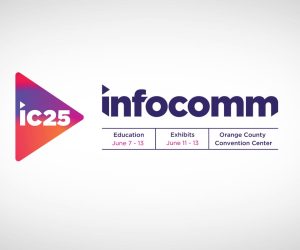
The Infocomm 100
We plunge head first into the AV Industry’s think tank.
Text:\ Peter Swanson, CTS
So, there you are, working away at your desk, sweating over the latest project design, when suddenly a letter is dropped into your in tray. This is a surprise, as more and more people communicate by email alone, unless it’s sending out product catalogues. You open up the letter and see that the InfoComm logo is there, but juxtaposed with the number 100. Reading on, you find that you’ve been invited to an event comprising 100 executives in the AV industry… and about now you realise just how fortunate you’ve been.
The InfoComm 100 began as an initiative in 2009 and was repeated in 2010. It comprises a mix of 100 people from around the globe and from all facets of the AV industry: consultants, integrators, manufacturers, technology managers and event professionals. To round this out, there are a few carefully-selected guests from related industries, such as architecture, project management and ICT.
Run under the auspices of the InfoComm Leadership Development Council, it is focused on leveraging the skills and knowledge of current industry leaders, but also about seeking out the next generation and giving them mentoring and networking opportunities. The intention is that each year 50% of the attendees will be drawn from the previous year and 50% will be new members. The intention is to balance useful experience gained from prior years with new insights from different thinkers.
TAKING THE PLUNGE
The program takes the form of a 1-2 day deep immersion in the current state of the AV industry and the directions in which it is likely to head over the next 3-5 years.
The inaugural event in 2009 happened to take place just as the GFC was coming home to roost for many companies around the globe. Along with many of the other attendees, I was wondering about how exactly we could be spending the time gazing off into the future when it seemed like our economic reality was crashing down around us. Fortunately, the InfoComm staff had considered this too and the introductory speaker, Rich Kaarlgard, gave an excellent talk that charted us through the current difficulties, considered past challenges in the world economy and left everyone feeling that the most important thing was to get on with making a difference to the industry by looking, and planning, forward. The discussions covered a huge amount of ground in very little time, including industry competition and structure; technology and science; market demographics; social values and client preferences; global economics and the business climate; and legislative, regulatory and political climate. In addition to all of these areas, the group also considered what the appropriate description of our industry was now and how it was changing.
The attendees from architecture, project management and ICT really helped to frame discussions in the context of the world beyond the confines of our industry.
It was inspiring to see so many leaders of the industry giving their time to such an event. There was a clear sense that people felt we had collectively achieved something of real value to the association, but had each gained greatly in a personal sense as well. Whether or not it was known or hoped for as an outcome in the event’s planning stage, I think one of the major benefits was getting a large number of industry leaders recharged and reinvigorated to make it through the GFC and continue their businesses into the future.
“”
It was inspiring to see so many leaders of the industry giving their time to such an event
GOING UNDER FOR THE SECOND TIME
By the time this year’s event came around, many people were feeling the economy was improving and as a result there was more of a ‘business as usual’ feel to proceedings. There were two key areas of focus on this occasion. The first was Building Information Modelling (or BIM) and the integrated project delivery it potentially facilitates, and the other was Social Media. The Social Media discussions ranged across its applications in the operation of AV business, the potential for projects that incorporate or build on Social Media, and the ways in which other facets of our industry may change as a result of Social Media functionality.
If it’s all starting to sound like a pretty heavy-duty couple of days, there is also plenty of time to network with your fellow ‘100 members’, and find out more about the state of the AV industry around the world. Surprisingly, the key thing you find when talking to people from a variety of countries, is that many of the approaches, problems and opportunities that we face here are replicated in their countries, but with variations due to local culture and language.
Naturally, the membership of any given year is limited (to, yes, you guessed it, 100), but if you are getting involved in moving the AV industry forward at a community/industry level there is always a chance you might be the next recipient of a ‘golden letter’. Whether or not you have the chance to attend, personally, I hope you will see both the short term value of InfoComm ‘supercharging’ a new generation of leaders, along with the long-term commitment to the industry’s well being implicit such an initiative.
InfoComm International: www.infocomm.org















RESPONSES